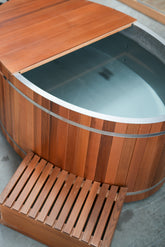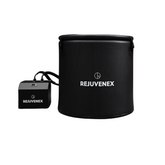Sauna vs Ice Bath: Choosing the Right Recovery Method for Your Body
When it comes to post-workout recovery or general wellness, two therapies dominate the conversation: saunas and ice baths. Both offer unique benefits, but their approaches—heat versus cold—target different physiological responses. This guide breaks down their advantages, optimal use cases, and key differences to help you decide which method aligns with your goals.
How Saunas and Ice Baths Work?
Sauna Therapy: Heat for Healing
Saunas use dry heat (traditional) or infrared light to raise your body temperature, triggering sweating and improved circulation. This process supports detoxification, muscle relaxation, and stress relief.
Ice Bath Therapy: Cold for Recovery
Ice baths involve immersing the body in cold water (50–59°F) to reduce inflammation, numb muscle pain, and sharpen mental resilience. The cold causes blood vessels to constrict, slowing metabolic activity and flushing out waste products post-exercise.
Health Benefits Compared
Key Benefits of Saunas
-
Muscle Relaxation: Heat loosens tight muscles and eases joint stiffness.
-
Improved Circulation: Increased blood flow delivers oxygen to tissues, speeding recovery.
-
Stress Reduction: Heat triggers endorphin release, promoting calmness.
-
Detoxification: Sweating removes toxins like heavy metals and lactic acid.
Downsides of a Sauna
Saunas aren’t perfect. Watch out for these.
-
Dehydration: You lose water fast. Drink up!
-
Heat Risk: Too long can cause dizziness or heatstroke.
-
Not for All: Pregnant women or heart patients need a doctor’s okay.
Key Benefits of Ice Baths
-
Inflammation Reduction: Cold limits swelling and soreness after intense workouts.
-
Faster Recovery: Constricts blood vessels to minimize muscle damage.
-
Mental Resilience: Boosts focus and tolerance to discomfort.
-
Enhanced Immunity: Cold exposure may strengthen immune response.
Downsides of an Ice Bath
Ice baths have limits too. Here’s what to know.
-
Uncomfortable: It’s cold! Takes willpower to stay in.
-
Short Sessions: Too long risks hypothermia.
-
Less Relaxing: Not as cozy as a sauna.
Suggested Image: A person stepping into an ice bath with a determined look.
Sauna vs. Ice Bath: Direct Comparison
|
Feature |
Sauna |
Ice Bath |
|
Temperature |
70–100°C (traditional) |
10–15°C (50–59°F) |
|
Session Duration |
15–30 minutes |
5–15 minutes |
|
Best For |
Stress relief, detox, flexibility |
Injury recovery, inflammation |
|
Ease of Use |
Requires dedicated space |
Portable tubs or modified baths |
|
Mental Challenge |
Relaxing |
High (cold shock) |
When to Choose a Sauna or Ice Bath?
Use a Sauna If:
-
You need to unwind after a stressful day.
-
Your goal is long-term cardiovascular health.
-
You have chronic muscle tension or arthritis.
Use an Ice Bath If:
-
You’re recovering from high-intensity training or sports injuries.
-
You want to build mental toughness through cold exposure.
-
You need quick relief from acute pain (e.g., sprains).
Combining Both: Contrast Therapy
Alternating between sauna sessions and ice baths (e.g., 10 minutes hot, 2 minutes cold) can:
-
Enhance circulation by forcing blood vessels to expand and contract.
-
Reduce muscle soreness more effectively than either method alone.
-
Improve energy levels and alertness.
Safety Tip: Always end with cold exposure to avoid overheating.
Tips for Using a Sauna or Ice Bath
New to either? Here’s how to do it right.
Sauna Tips
-
Drink water before and after.
-
Start with 10 minutes—build up slowly.
-
Cool off gently—don’t rush outside.
Ice Bath Tips
-
Add ice to 12-15°C water—don’t go too cold.
-
Breathe steady to handle the chill.
-
Limit to 10 minutes your first time.
Which Costs Less?
Ice baths are cheap to start. Ice baths cost around $599 Saunas need investment—$1,500 for a basic infrared kit, up to $5,000 for traditional. But saunas last year, while ice baths need fresh ice each time. Short-term? Ice wins. Long-term? Sauna’s worth it.
Optimizing Your Recovery Routine
For Athletes
-
Pre-Competition: Use saunas to relax muscles 24 hours before an event.
-
Post-Competition: Ice baths within 30 minutes of activity reduce inflammation.
For Mental Health
-
Saunas: Reduce cortisol (stress hormone) levels.
-
Ice Baths: Increase norepinephrine, improving focus and mood.
Final Thoughts
Saunas and ice baths are powerful tools with distinct strengths. Heat therapy excels in relaxation and long-term wellness, while cold therapy shines in acute recovery and mental resilience. For best results, experiment with both methods and track how your body responds.
FAQS:
1. Can I use a sauna and ice bath on the same day?
Yes! Many athletes practice contrast therapy for enhanced recovery. Start with heat, then switch to cold, and repeat 2–3 times.
2. Which is better for weight loss?
Saunas promote short-term water weight loss through sweating, while cold exposure may boost metabolism by activating brown fat. Neither replaces diet or exercise.
3. Are ice baths safe for heart health?
Consult a doctor if you have cardiovascular issues. Cold immersion raises blood pressure temporarily, which can be risky for some.
4. How often should I use a sauna?
3–4 sessions weekly (15–30 minutes each) are ideal for long-term benefits.
5. Can I take an ice bath at home?
Yes! Fill a tub with cold water and ice, aiming for 50–59°F. Beginners should start with 3–5 minutes.




